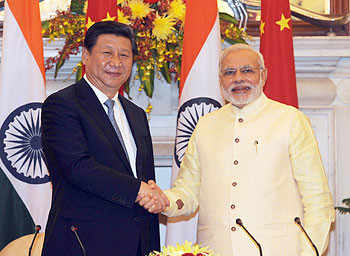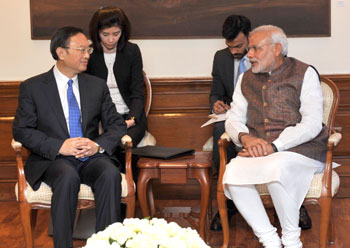INDIAN ARMED FORCES CHIEFS ON OUR RELENTLESS AND FOCUSED PUBLISHING EFFORTS

SP Guide Publications puts forth a well compiled articulation of issues, pursuits and accomplishments of the Indian Army, over the years

"Over the past 60 years, the growth of SP Guide Publications has mirrored the rising stature of Indian Navy. Its well-researched and informative magazines on Defence and Aerospace sector have served to shape an educated opinion of our military personnel, policy makers and the public alike. I wish SP's Publication team continued success, fair winds and following seas in all future endeavour!"

Since, its inception in 1964, SP Guide Publications has consistently demonstrated commitment to high-quality journalism in the aerospace and defence sectors, earning a well-deserved reputation as Asia's largest media house in this domain. I wish SP Guide Publications continued success in its pursuit of excellence.
- Indian Air Force Aims for Full Indigenous Inventory by 2047 — Air Chief Marshal A.P. Singh
- Rajnath Singh assumes charge as Defence Minister for the second consecutive term
- Interim Defence Budget 2024-25 — An Analysis
- Union Defence budget 2024
- Prime Minister Modi Flies in the LCA Tejas
- New Chapter in India-Italy Defence Ties
- Airpower beyond Boundaries
Modi to visit China - Multiple Challenges


Summit after summit has failed to resolve the contentious border issue between India and China and once again all eyes are now on the May end visit of the Prime Minister Narendra Modi to China. These summits have indeed resulted in political bonhomie in the capitals. Also there have been assertions and commitments from both the sides to maintain cordial relations and not allow the border row to impinge on evolving multifarious relations between the two Asian giants. However, the bonhomie in the capitals have not helped relax the atmosphere on the 4000 kms Line Of Actual Control (LAC).
Resolving bilateral disputes and issues with China have proved to be the most challenging on the foreign policy front . China has not only shown obduracy and aggressive behavior on the LAC but also challenges and teases India on the international trade highway projects, by indulging in nefarious infrastructure development games in countries like Sri Lanka and Maldives. India seems to be suspicious and apprehensive on many of the Chinese offers to join its ambitious international projects like the One belt One road and Maritime Silk Road projects, and the trans -Himalayan corridor linking Tibet, Nepal and India. It has also offered to extend the China- Pakistan economic corridor to India and has been convincing India to initiate work on the development of BCIM corridor , which runs through Yunnan province of China , Myanmar , Bangla Desh and India. These were the issues taken up during the visit of the Chinese State Councilor Yang Jie Chi from March 22 to 24. Though India has pleased China by joining the Asian Infrastructure Investment Bank as a founder member, India remained non committal on Chinese mega trade highway projects.
No outcome
The visit of the Chinese State Councilor as the Special Representative of the Chinese Prime Minister on boundary and territorial issues expectedly did not produce any concrete result, but when he met Modi, he hoped that concrete outcomes from his May visit to China will emerge and will take the relationship to a new level. The September end visit of Chinese President Xi Jin Ping has definitely not assisted in the forward movement of the contentious boundary and territorial issues. And the forthcoming visit of Modi does not appear to be very result oriented though the two countries will continue to tell the world that relations are warm and stable between them.
The first ever boundary negotiations under the new regimes of Modi and Chinese President Xi Jinping has also not officially talked of any forward movement. After the conclusion of the talks the External Affairs Ministry spokesperson Sayeed Akbaruddin repeated the usual, “The talks were marked by cordiality and candour and were held in a constructive and forward looking atmosphere.”
Code of conduct for LAC
The Chinese side made a clever offer to India to initiate a new dialogue on the Code of Conduct for the LAC, but India seems to have refused to even entertain the idea, which proposes that both sides should not plan or build new infrastructure projects on both sides of the LAC. As India is a late comer in infrastructure construction like mountain rail and road projects and forward air strips, it will be put to tactical disadvantages, if it agrees to the Chinese demands, India certainly cannot think of leaving the entire inaccessible border areas to the mercy of the Chinese forces. India needs to develop the backward areas near the LAC , so as to uplift the living standards of the border population and economically integrate them better with the rest of the country. On the other hand India repeated its earlier requests to the Chinese border team in Delhi to agree for early demarcation of the 4000 kms LAC, to avoid confrontation. Expectedly there was no positive response from the Chinese side.
According to Srikanth Kondapalli , noted China expert , “ very tactfully the Chinese side had shifted the discourse towards the eastern side of the territorial dispute and refuses, since the first Special Representative meeting , to discuss the Aksai Chin and contiguous areas. Also, China’s military leaders’ visits to Aksai Chin go unnoticed with hardly any criticism from the Indian side.”
However, after the talks China seemed to be moving positively towards Indian stand that early resolution of the border and territorial issues will lead to removal of major bottlenecks in the bilateral relations. China also expressed its readiness to achieve more progress in finding a solution to the very complicated issue.
China’s grandiose plans
China perhaps is realizing that its grandiose economic infrastructure plans will not succeed if India is not taken on board. India is a vital link in the grand Chinese designs and taking India along will increase the weight, significance and fruitfulness of Chinese economic and trade routes. According to Indian diplomatic sources, India will be amenable to join Chinese infrastructure projects if it’s fears of Chinese strategic dominance are dissipated. Much will depend on the Chinese forward movement on border issues, which will persuade Indian strategic planners to be more amenable to Chinese insistence to join its projects. It will also be in India’s interest to join the Chinese initiated projects, but India must insist that India will participate in these as equal partner and part of the infrastructure projects falling in Indian area of influence will be handed over to India for development. For example if China maintains a good distance from countries like Maldives, Sri Lanka and Seychelles etc it will assuage India’s concerns. India’s fears of Chinese dominance in the Indian Ocean area will subside.
Pakistani prism
China must also ensure that its all-weather friendship with Pakistan does not cast an evil eye on India’s national interests. India also needs to be reassured that Chinese side will open its market for Indian Pharma, agriculture and IT products, in the absence of which the trade balance remains heavily tilted in favor of China, which had reached to a figure of US$70 billion. If China has to rise fast as a power to the global level it must dissuade India from falling in the lap of western alliances of US, Japan and Australia. Both India and China are already cooperating in multilateral fora of leading developing countries like the BRICSA and the India, China , Russia trilateral grouping. These multilateral groupings have strong potential of emerging as rival to western led alliances , provided China is able to cajole India to join its bandwagon , through the carrot of an early resolution of border disputes.
The issue of India joining Chinese led trade routes will once again figure prominently during the forthcoming visit of Modi. Both the countries must come to a common understanding on the future of Afghanistan and China must not view Afghanistan through the Pakistani prisms. There is lot of scope for India and China to cooperate in stabilizing South and Central Asia, which are the new growth and investment areas for India and China. Taliban and other extremist forces can only be tamed if China and India come together. Only China can convince Pakistan to shed its anti - India strategy of using Afghanistan as strategic depth and promoting Taliban. If China wants to fast forward its silk routes projects it must take into account India’s concerns - both bilaterally and multilaterally and stop viewing India through the prism of Pakistan. In order to win India’s support, China must also come out with a positive stand on India’s aspirations to join the United Nations Security Council, the Nuclear Suppliers Group and other export control regimes.





